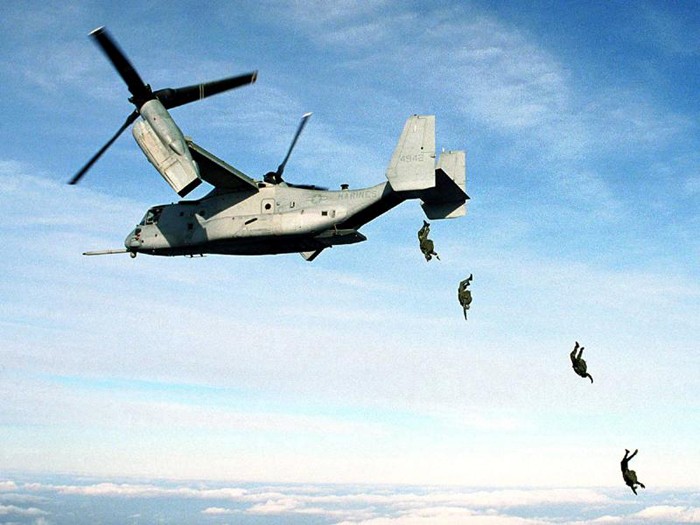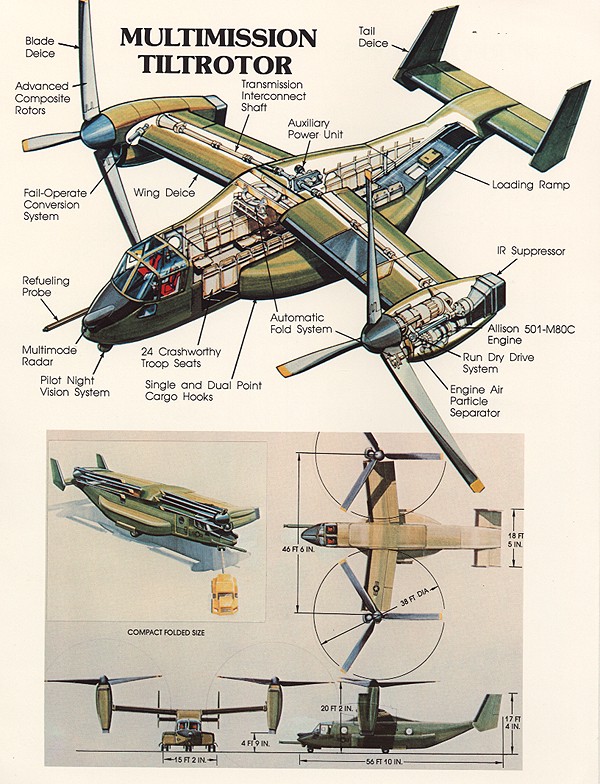V-22 Osprey

Bell Boeing Specifications
Width (rotors turning): 83 feet 8 inches
Fuselage Length: 57 feet 4 inches
Length (stowed): 62 feet 7 inches
Width (stowed): 18 feet 5 inches
Horiz. Stabilizer Width: 18 feet 5 inches
Height (helicopter mode): 21 feet 8 inches
Vertical Stabilizer Height: 17 feet 7 inches
Max. Speed (sea level): 275 knots
Vertical Rate of Climb (sea level): 1,090 fpm
Max. Rate of Climb (sea level): 2,320 fpm
Service Altitude: 26,000 feet
Service Ceiling OEI: 11,300 feet
Hoever OGE: 14,200 feet
Range Amphibious Assault Mission: 515 nautical miles
Max. Self Deploy: 2,100 nautical miles
Accommodation: Cockpit 2; Cabin 25
Contractor: Bell Boeing

The U.S. Marine Corps MV-22B completed operational evaluation (OPEVAL) in July 2000 at Marine Corps Air Station (MCAS) New River, N.C., after eight months of extensive flight testing to evaluate its suitability for operational use. As with most new aircraft, the Osprey has gone through some teething problems, including an unfortunate mishap in April during the operational evaluation phase. However, after a thorough investigation, the aircraft was cleared to fly again two months later.
The Multi-service Operational Test Team-comprising Marine and Air Force pilots, aircrew, maintenance personnel, operations analysts and flight engineers-put the aircraft through rigorous tests to evaluate the MV-22's readiness to join the fleet. Navy, Marine Corps and Air Force test sites were chosen for their diverse climates, altitudes and supporting assets. The aircraft conducted operationally representative missions from air-capable ships, airfields, remote sites, confined areas and major range and test facilities. This allowed the team to determine how the Osprey operates with other aircraft, including the CH-46 Sea Knight, CH-53 Sea Stallion, F/A-18 Hornet, AV-8B Harrier II and Marine Corps and Air Force tankers.
Earlier this year (2000), the Osprey was integrated into a Marine Aviation Weapons and Tactics Squadron 1 exercise at MCAS Yuma, Ariz., to gain valuable feedback from the Marine Corps before the MV-22 enters full-rate production, scheduled for late 2000.
In June 2000, the Marine Corps' four MV-22Bs resumed OPEVAL at Naval Air Warfare Center Weapons Division China Lake, Calif. To demonstrate his confidence in and support of the aircraft, General James L. Jones, Commandant of the Marine Corps, flew as a passenger in the first MV-22 cleared to carry passengers since the mishap. Gen. Jones remarked, "Marines pioneered the military use of helicopters [during the Korean War], creating the conditions for a new form of maneuver that radically altered the nature of tactics, with global military implications. The MV-22 is another such innovation. It represents a major step in a new direction, and it is the best aircraft available today for the missions of tomorrow."
The MV-22B's tilt-rotor design offers some significant advantages over traditional helicopters. It can go into hostile areas at higher speeds, yet in hover mode can offload troops without having to land on a runway. With its range, the Osprey is able to fly around threats rather than through them, giving the Marines greater flexibility during sorties. Conversion from the helicopter hovering mode to forward airplane flight takes only 12 seconds. The wings become lift effective between 100 and 120 knots.
With OPEVAL completed, the low-rate initial production aircraft used during the critical flight test phase have been turned over to Marine Medium Tilt-Rotor Training Squadron 204, the new MV-22 training unit. Located at MCAS New River, N.C., VMMT-204 will train both Marine and Air Force Osprey pilots. The Marines are planning to purchase 360 MV-22s, the Air Force 50 special operations CV-22s, and the Navy 48 search and rescue HV-22s.
The MV-22B's unique capabilities constitute an exciting platform for the future. "The Osprey," Gen. Jones said, "will provide our Marines with a needed edge in the complex operations they will face while defending Americans and American interests in the 21st century."


